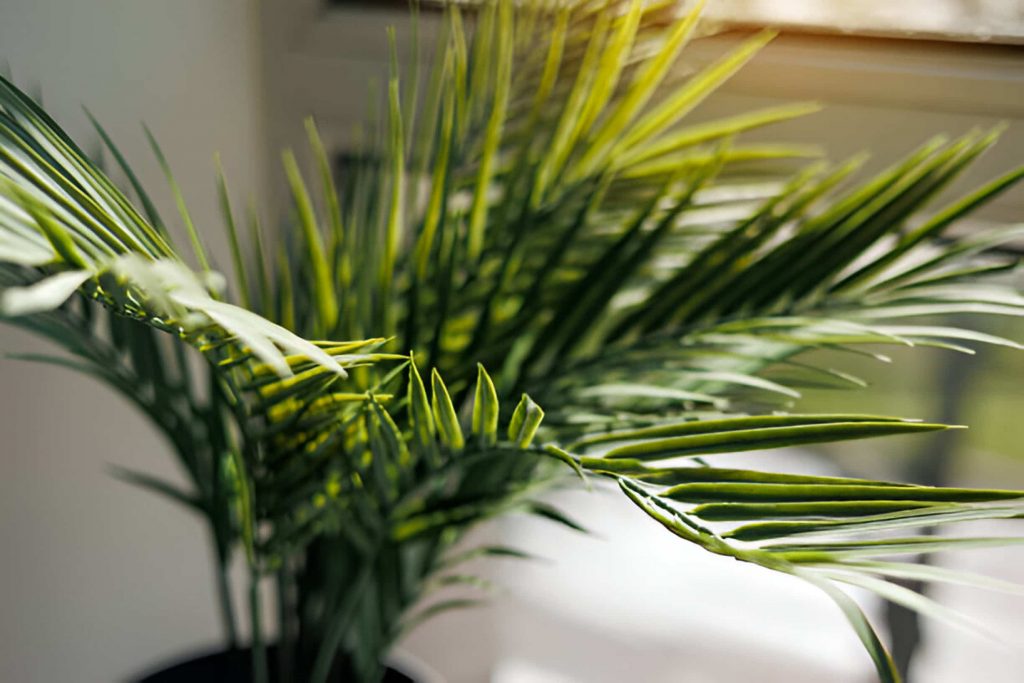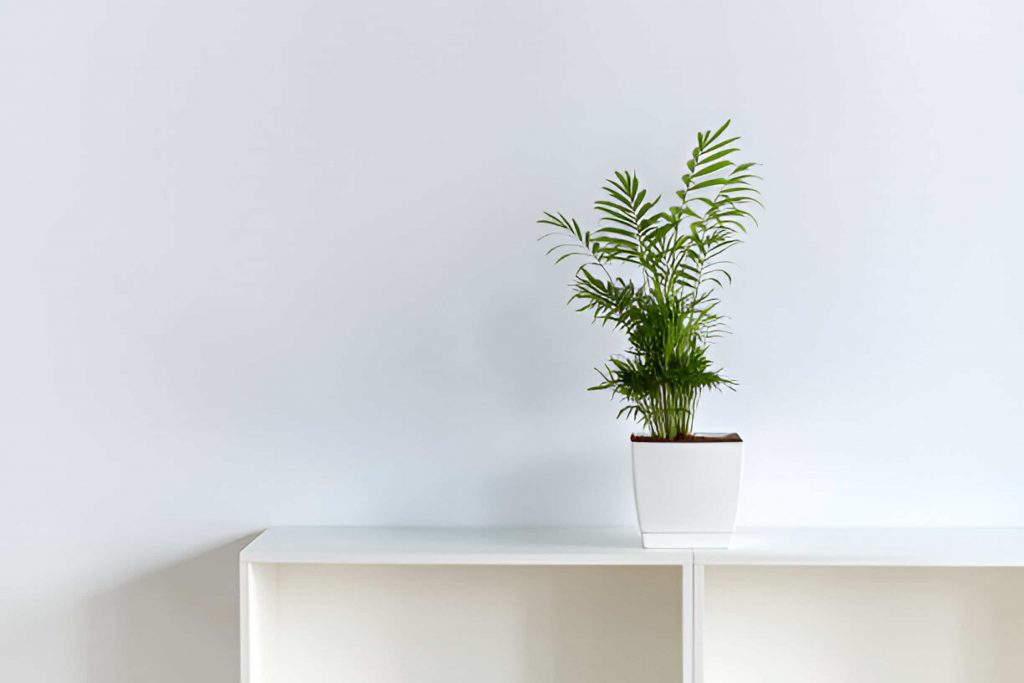
The lush green fronds of the bamboo palm (Chamaedorea spp.) add a touch of the tropics to any indoor space. But despite its exotic appearance, the bamboo palm is a surprisingly easy houseplant to care for. This guide will equip you with all the knowledge you need to keep your bamboo palm thriving for years to come.
What is the Bamboo Palm Plant?
The Bamboo Palm plant, also known as the Parlor Palm, Reed Palm or good luck plant, is a type of palm tree belonging to the genus Chamaedorea. It’s a subtropical palm that thrives in warm and humid environments. While some species can grow up to 20 feet outdoors in ideal conditions (zones 10-11), Bamboo Palms are more commonly grown indoors as houseplants due to their manageable size and low-light tolerance.
Bamboo Palms are known for their slender, upright canes that resemble bamboo stalks. Their feathery fronds with deep green, pinnately divided leaves add a touch of the tropics to any indoor space. These easy-care plants are popular choices for beginner plant owners as they require minimal maintenance to thrive.tunesharemore_vert
QUICK FACTS:
Botanical Name: Chamaedorea seifrizii
Family: Arecaceae
Mature Size: 3-8 ft. tall, 1-10 ft. wide
Sun Exposure: Partial sun, shade
Soil Type: Moist, well-drained (slightly acidic)
Hardiness Zones: 10-11 (native to Mexico and Central America)
Characteristics
While its name suggests otherwise, the bamboo palm is not actually a bamboo. True bamboo is a grass, while the bamboo palm is a true palm tree. Real bamboo needs plenty of sun and grows much larger than the indoor-friendly bamboo palm.
Cleaning the Air
The bamboo palm stays on the smaller side, making it ideal for apartments or smaller homes. Even better, it acts as a natural air purifier, removing common toxins like formaldehyde and benzene from your indoor environment. That’s why plants for clean air is one of the best.
Decoration
The bamboo palm’s graceful, feathery fronds and slender trunk add a touch of sophistication to any room. It’s a perfect way to brighten up a neglected corner or add a pop of greenery to your living space.
Bamboo Palm Care

While some houseplants demand constant attention, the bamboo palm thrives on a laid-back approach. Unlike its high-maintenance counterparts, this tropical wonder is a breeze to care for. Here’s a quick guide on Bamboo Palm Care:
Lighting Conditions
Despite its tropical origins, forget basking your bamboo palm plant in direct sunlight. It prefers indirect, filtered light or even gentle shade. Remember, a sudden shift in lighting can shock the plant, so if you need to move it, do so gradually.
Temperature and Humidity
Think warm and humid – that’s the ideal climate for your bamboo palm. The sweet spot for temperature is between 65 and 80 degrees Fahrenheit. If your home tends to be on the drier side, especially during winter, misting the plant regularly will help mimic its preferred humidity levels. Keep it away from drafts and cold windows for optimal health.
Watering
While bamboo palms enjoy moist conditions, they don’t want to be swimming. The key is to find the happy medium – consistently moist soil, but not soggy. Here’s a helpful trick: Stick your finger into the soil. If the top inch feels dry, it’s watering time. Drench the soil thoroughly until water drains out the bottom of the pot. Remember, overwatering is a recipe for root rot, so err on the side of underwatering.
Soil
Use a well-draining potting mix formulated for houseplants. You can improve drainage by adding perlite or orchid bark to the potting mix.
Fertilizer
Feed your bamboo palm a balanced liquid fertilizer once a month during the growing season (spring and summer). Dilute the fertilizer according to the manufacturer’s instructions.
Common Problems
Brown leaf tips can indicate underwatering, while yellowing leaves may be a sign of overwatering or insufficient light.
Pests
Bamboo palms are relatively pest-resistant. However, they can be susceptible to mealybugs and scale. Treat infestations with insecticidal soap or neem oil.
How to Plant a Bamboo Palm
Planting a bamboo palm is a simple process. Choose a pot with drainage holes slightly larger than the root ball. Fill the pot with fresh potting mix, leaving room at the top for watering. Gently place the palm in the pot and fill the remaining space with potting mix, firming it gently. Water thoroughly and allow the excess water to drain.
Pruning
Pruning isn’t just about aesthetics for your bamboo palm. It promotes overall plant health. Regularly inspect your palm for dead or yellowing leaves. When you spot one, use sharp, clean bypass pruners to snip it off at the base of the stem. This prevents the unhealthy leaf from affecting the rest of the plant.
Propagation
Bamboo palms can be propagated by division. Carefully remove the palm from its pot and separate the clumps with sharp, sterilized tools. Repot each division in its own pot with fresh potting mix.
Repotting
Repot your bamboo palm every 2-3 years or when it becomes rootbound. Choose a pot only one size larger than the current pot.
Overwintering
During winter, protect your bamboo palm from cold drafts and sudden temperature fluctuations. Reduce watering slightly and avoid fertilizing.
Bamboo Palm Varieties

There are several varieties of bamboo palm available, each with slightly different characteristics. Some popular choices include:
- Chamaedorea elegans (Golden-cascading palm)
- Chamaedorea seifrizii (Broadleaf lady palm)
- Chamaedorea erumpens (Bello palm)
Frequently Asked Questions About Bamboo Palm Care
How Long Do Bamboo Palms Last?
With proper care, bamboo palms can live for many years, even decades indoors.
Are Bamboo Palms Toxic to Cats and Dogs?
No, bamboo palms are not considered toxic to cats and dogs by the ASPCA. However, it’s always best to supervise pets around houseplants to prevent them from chewing on the leaves.
By following these simple tips, you can ensure your bamboo palm thrives and adds a touch of elegance to your home for years to come.
